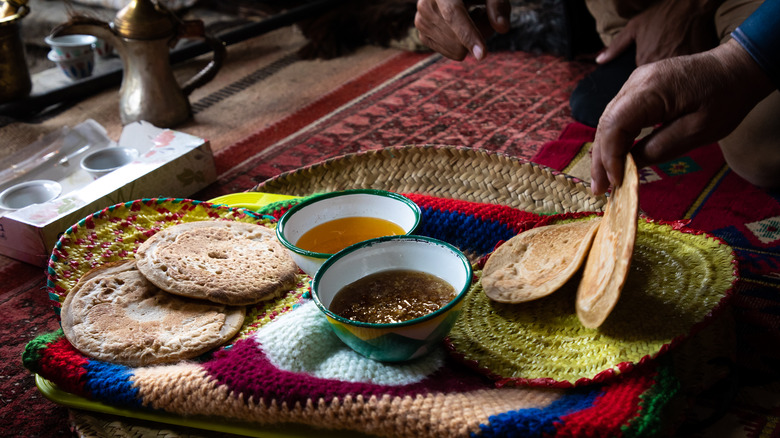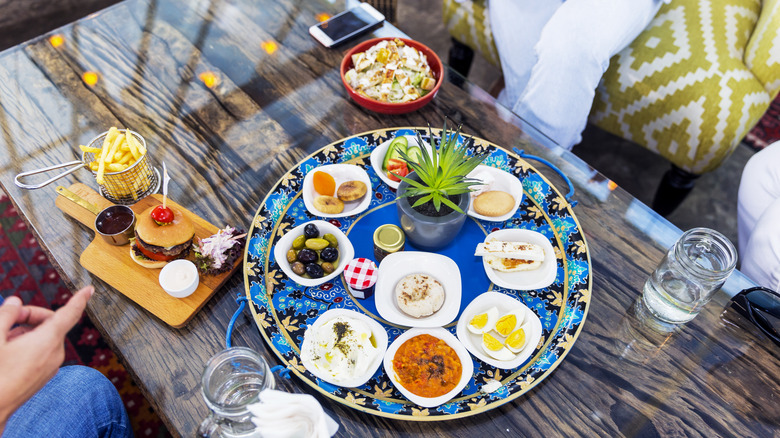Why Left-Handed Eating Is Frowned Upon In The Middle East
In many parts of the world, it's not uncommon for hands to be the go-to utensils for enjoying a meal. For most of human history, hands have been the primary tool for most things, food consumption included. Today, the tradition is governed by cultural etiquette rules in much of India, Africa, and the Middle East – the birthplaces of human civilization. In majority-Muslim countries, Islamic doctrine dictates that food should be consumed with the right hand, a decree by the Prophet Muhammad that can be found in the Qur'an. This is one of the reasons why in most Middle Eastern countries, the left and right hands have distinct purposes when it comes to activities involving cleanliness and consumption.
Custom dictates that the left hand should be reserved for bodily hygiene purposes, or "unclean" activities, while the right hand is favored for eating, greeting, and other such "clean" activities. It's best practice to default to the right hand for gift-giving, handing over money, or greeting another person – while the left is primarily for cleaning oneself. For this reason, using the left hand to eat or shake someone's hand is considered not only unhygienic but potentially insulting as well.
Cleanliness is next to holiness
While Muslims are not the only people to prefer right-handed eating, it is a practice that is recorded in their holy text, the Qur'an. In a verse about eating and drinking, the Prophet Muhammad states that the devil eats and drinks with the left hand, and so those who wish to be holy and clean must use the right.
Mealtime is an intentional, often social activity, so proper eating etiquette is paramount. Sharing food is a gesture of friendship, and observing sacred and hygienic eating customs is a show of respect and goodwill. Since many meals in Middle Eastern countries are shared from a large, communal dish, clean hands are a must.
Left-handed people might find defaulting to their right hand for social tasks more difficult, but it's best to be mindful, lest you unintentionally insult or offend someone. Arab countries have some of the lowest rates of left-handedness in the world, likely in part because naturally left-handed children are often taught to use their right hand from a young age. When it comes to the left and right-hand rules, there are very few exceptions to the traditional practices.
Other mealtime norms to know
Right-handed eating isn't the only rule when it comes to much Middle Eastern dining etiquette. Halal food rules dictate the meat slaughter and preparation methods that are acceptable for Muslim people to consume. Halal foods can be found all around the world, with American cities such as New York having very diverse halal food scenes to explore. For example, eating pork and its byproducts is not halal, so you won't often see it on the menu in Middle Eastern countries.
Alcohol consumption is also forbidden for Muslim people — though there is a traditional and trendy liquor, Arak, that has been gaining some international popularity. While alcohol is sometimes offered at hotels and restaurants that cater to tourists, it's best not to ask for it at local establishments if it's not advertised.
It's considered polite to leave a little bit of food on your plate when you are full, as an empty dish will imply that you did not get enough to eat. A generous host will likely serve you more food when they see an empty plate before you, so a leftover bite or two is a good way to indicate that you have eaten your fill. Of course, every culture has unique, traditional practices when it comes to mealtime. Learning how to respectfully share a meal with someone from another part of the globe is key to enjoying and appreciating all of the delicious things this world has to offer.



